In the lush green landscapes, the sight of hawks in Georgia soaring high in the sky is not an uncommon one. These magnificent birds of prey are integral to the diverse ecological tapestry that characterizes the Peach State. Known for their sharp hunting skills, impressive wingspans, and distinct cries, hawks evoke a sense of fascination and respect among wildlife enthusiasts and casual observers alike.
Across Georgia, from the coastal plains to the Appalachian foothills, these avian predators can be found, enriching the state’s wildlife with their presence. This guide offers an exciting foray into the captivating world of hawks in Georgia, setting the stage for a deeper appreciation of these incredible creatures.
List of Hawks in Georgia
Red-Tailed Hawk – the most common hawk in Georgia, often seen soaring in wide open areas, they are frequently spotted around the Blue Ridge Mountains and along the Appalachian Trail.
Red-Shouldered Hawk – prefers wooded areas near water bodies. The Okefenokee National Wildlife Refuge and Piedmont National Wildlife Refuge are great places to spot these hawks.
Cooper’s Hawk – Cooper’s Hawks, famous for their skilled hunting in both woodland and suburban areas, head to Chattahoochee River National Recreation Area for a good chance to observe these agile predators.
Broad-Winged Hawk – Less common but can be spotted during the migratory seasons in Georgia, their spectacular migrations in large flocks, known as “kettles”. The best time to witness this phenomenon is in the fall at the Kennesaw Mountain National Battlefield Park.
Sharp-Shinned Hawk – Sharp-Shinned Hawks, the smallest hawk species in Georgia, are relatively elusive due to their preference for dense forests. They have similar hunting habits to Cooper’s Hawks, making them difficult to distinguish at a glance. Their presence is notable in the densely forested areas of the Cohutta Wilderness.
Northern Harrier – can occasionally be seen in open grasslands and marshes. Bird-watchers might encounter this unique raptor at the Harris Neck National Wildlife Refuge or the Altamaha Wildlife Management Area.
Other birds of prey in Georgia along with the Georgia hawks include great horned owls (found in deep forest cover) which are a common site and many other species.
Hawks in Georgia Photo Guides
Red-tailed Hawk (Buteo jamaicensis)

The Red-tailed Hawk is a large bird of prey that is commonly found across North America. This species is part of the genus Buteo, which is often referred to as the “true hawks,” and includes more than two dozen species of raptors.
Red-tailed Hawks have a robust size, ranging from 18 to 26 inches in length and sporting a wingspan that can exceed 4 feet. They have a broad, rounded set of wings and a short, wide red tail. This species is most easily recognized by its rich, rust-colored tail, which gives it its common name. However, juvenile hawks might not yet have this distinctive feature.
Their feathers are generally dark brown on their dorsal side (back) with a lighter, often speckled, ventral side (front). The intensity and pattern of their plumage can vary significantly based on their age and geographic location, as there are about 14 recognized subspecies of Red-tailed Hawks.
As for their diet, Red-tailed Hawks are carnivores and have a broad diet that includes rodents, ground rabbits, reptiles, and other birds. They are skilled hunters that typically sit on high perches and use their keen eyesight to spot potential prey. Once they have identified a target, they swoop down to capture it with their powerful talons.
Red-tailed Hawks mate for life and build nests high off the ground, often in tall trees or on cliff edges. Their nests are made of sticks and can be quite large. They typically lay 1-3 eggs per year, which are incubated by both parents.
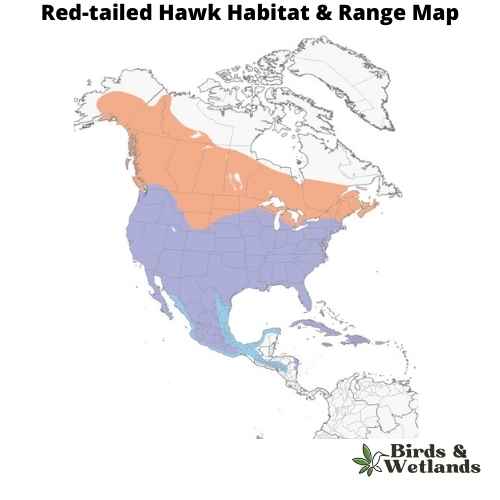
Red-tailed Hawk Sound
Red-shouldered Hawk (Buteo lineatus)

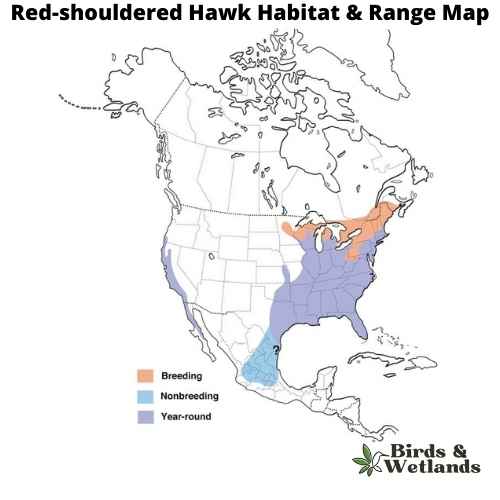
Listen:
The red-shouldered hawk are medium sized birds of prey, part of the buteo hawks family. It can be distinguished from other hawks by its reddish iris and pale legs.
The adult has rusty red upperparts, white underparts, a black chin and throat, and a reddish brown stripe over each eye, reddish brown heads and a strongly banded tail. The tail is reddish brown with two paler bands across it and they have white checkered wings. Juveniles are brown with dark barring and have pale fringes on the feathers of their wings.
Red-shouldered hawks nest in trees, though they also inhabit manmade structures including barns, bridges, and buildings. They prefer wooded areas with an open canopy but will use other places as well for nesting such as shrubs and hedges if needed.
The red-shouldered hawk’s diet – they eat small mammals such as ground squirrels, rabbits, voles, mice and rats. They also eat birds such as quail, pigeons and doves; reptiles including snakes; amphibians; fish; crustaceans; insects; and carrion (dead animals).
Cooper’s Hawk (Accipiter cooperii)

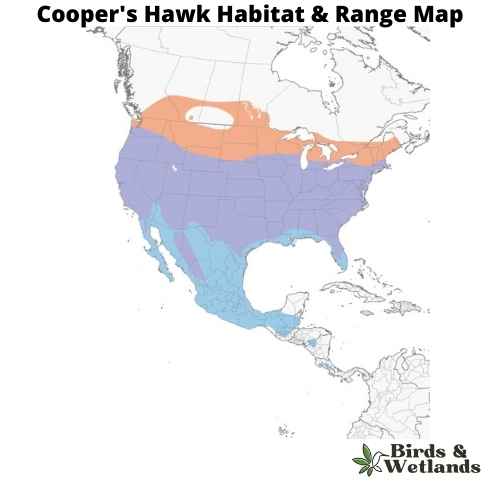
Listen:
The Cooper’s Hawk is a medium-sized bird of prey native to North America. Known for its agility and speed, it is part of the Accipitridae hawk species, which also includes other hawks, eagles, and kites.
Cooper’s Hawks are typically about 14 to 20 inches in length, with a wingspan ranging from 27 to 36 inches. They are known for their distinctive long, rounded tails and short, rounded wings. They have a steely blue gray top, with rusty bars on their underparts and thick, dark bands on their tails.
The Cooper’s Hawk is a skilled predator, primarily hunting birds and small mammals. They are adept at hunting in both dense forests and open areas, often catching prey mid-air in high-speed pursuits. They have also been known to visit the backyard bird feeder, not for the seed, but to prey on the smaller birds that gather there.
Cooper’s Hawks often build nests in dense tree canopies where they are well concealed. The female usually lays 3 to 5 eggs, and both parents share incubation duties. The young hawks fledge after about a month but will stay close to the nest, relying on their parents for food as they learn to hunt.
Broad-winged Hawk (Buteo platypterus)

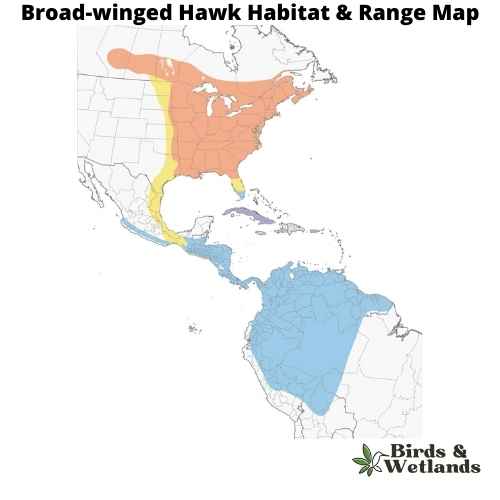
Broad-winged Hawk Sound
The Broad-winged Hawk holds a commanding presence as one of the largest hawks in the world, known for its broad wings. Its formidable size is a testament to its prowess as a bird of prey, effortlessly navigating the open skies in search of food.
Their distinctive appearance sets them apart. The adults exhibit a striking black and white pattern, complemented by a rusty breast and buff underparts and brown wings. In contrast, juveniles are adorned with a brown plumage, marked by pale edges on their feathers, adding to their distinctive youthful charm.
These hawks are most commonly found in open areas, such as farmlands or grasslands interspersed with scattered trees, which provide optimal conditions for when hawks hunt.
When it comes to their diet, Broad-winged Hawks feed on small rodents like mice, rats, squirrels, rabbits, and voles. Broad winged hawks breed during the spring and summer months then migrate to central and south America.
Sharp-shinned Hawk (Accipiter striatus)

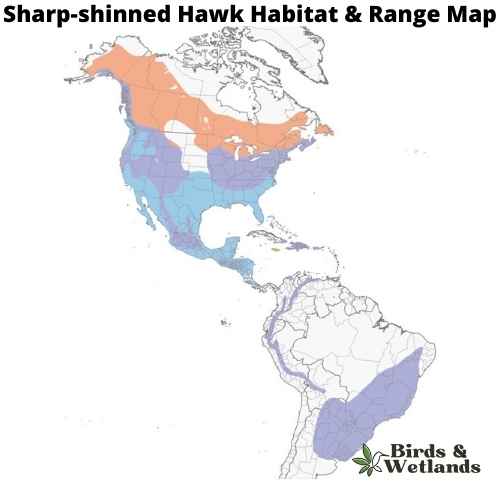
Listen:
The adult bird is brown on top and white underneath, with a dark brown band across its chest. It has short, rounded wings and a long tail that makes it look larger than it actually is. Adult sharp shinned hawks have black eyes, which are surrounded by white feathers. The female Sharp-shinned Hawk is browner than the male, who has darker brown markings on his back.
Sharp-shinned Hawks prefer open country for their habitat, including fields and meadows where they can hunt for mice and other small animals. They can be found throughout the United States but are most common in the east.
Sharp-shinned Hawks eat mostly small birds, such as sparrows and warblers, as well as small mammals such as mice and gophers. They catch prey by surprise using their incredible speed and agility, diving out of the sky at speeds up to 200 mph.
Sharp-shinned Hawks have an unusual hunting style for hawks—they prefer to catch their prey from perches above trees or telephone wires, rather than swooping down from above like most other hawks do and can often be seen hunting near bird feeders.
Northern Harrier (Circus hudsonius)

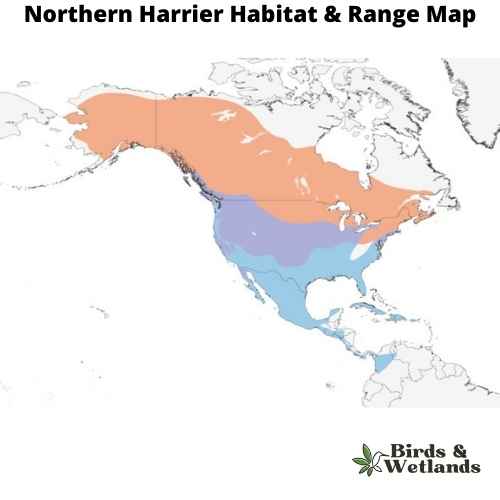
Listen:
The Northern Harrier is a medium-sized, slender hawk.
Adult birds are gray above, with pale bars on the wing feathers and white markings on the underwings and a white rump patch. The breast is barred with black and white, and the belly is streaked with brown.
They prefer open areas, such as grasslands and marshes, but can be found in almost any open habitat except dense woods.
Northern Harriers are opportunistic hunters that feed on small mammals such as mice, voles and rabbits as well as birds including quail, grouse and ducks. They hunt by flying low over open spaces such as fields or marshes.
Northern harrier nests on the ground in lowlands or hillsides near water bodies. It lays two to four eggs which hatch after 24 days of incubation by both parents. The chicks fledge after 30 days of hatching and remain dependent on their parents for another three weeks during which they learn how to fly.
Where to Spot Hawks in Georgia
Georgia is a haven for hawk-watching enthusiasts, offering diverse habitats and abundant birdlife. While I can provide you with information based on available knowledge up until September 2021, please note that specific locations and conditions may have changed since then.
Okefenokee Swamp Located in the southeastern part of Georgia, the Okefenokee Swamp is a vast and pristine wilderness that provides an ideal habitat for a variety of hawk species. While exploring this unique wetland, birdwatchers may spot Red-shouldered Hawks (who go back to the same nest each year during breeding season), Swallow-tailed Kites, and even the occasional Bald Eagle soaring above the cypress trees and blackwater rivers.
Piedmont National Wildlife Refuge Situated in middle Georgia, the Piedmont National Wildlife Refuge offers a mix of forests, grasslands, and wetlands that attract a wide range of bird species, including hawks and other medium sized birds. Here, visitors may have the opportunity to observe Red-tailed Hawks, Cooper’s Hawks, and the elusive Northern Harriers as they hunt for prey and eat small mammals or glide gracefully across the open fields.
| Neighboring State | Best Hawk Watching Sites |
|---|---|
| Alabama Hawks | Cheaha State Park |
| Florida Hawks | St. Marks National Wildlife Refuge |
| South Carolina Hawks | Caesar’s Head State Park |
| Tennessee Hawks | Lookout Mountain |
| North Carolina Hawks | Chimney Rock State Park |


